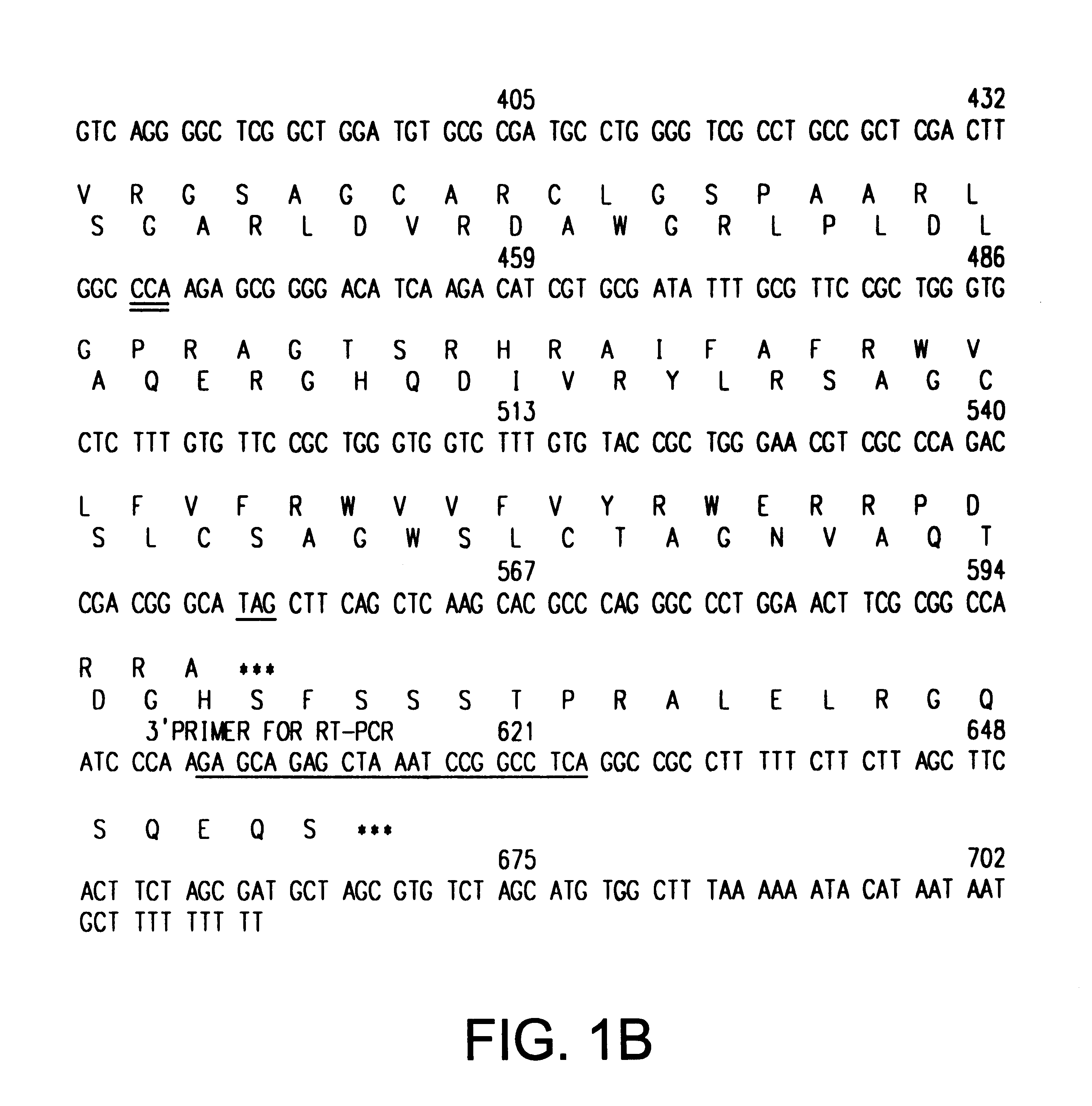ARF-P19, a novel regulator of the mammalian cell cycle
a cell cycle and novel technology, applied in the field of arf-p19, can solve the problems of knockout animals being particularly susceptible to developing spontaneous tumors
- Summary
- Abstract
- Description
- Claims
- Application Information
AI Technical Summary
Problems solved by technology
Method used
Image
Examples
example 1
cDNA Sequences Encoding ARF-p19
Tandemly linked INK4A (MTS1, CDKN2) and INK4B (MTS2) genes on the short arm of human chromosome 9 encode distinct 16 kDa and 15 kDa inhibitors (InK4a-p16 and InK4b-p15, respectively) of the G1 cyclin D-dependent kinases CDK4 and CDK6 (Serrano et al., Nature 366:704-707 (1993); Hannon and Beach, Nature 371:257-261 (1994)). Homozygous co-deletion of INK4A and INK4B, hemizygous deletions of INK4A together with point mutations within the remaining allele, and de novo methylation of an CpG island extending into exon 1 of INK4A (Merlo et al., Nature Med. 7:686-692 (1995)) are commonly observed in human cancers, suggesting that InK4a-p16, and perhaps InK4b-p15, function as tumor suppressors (Kamb, A. et al., Science 264:436-440 (1994); Noburi, T. et al., Nature 368:753-756 (1994); Sheaff and Roberts, Curr. Biol. 5:28-31 (1994); Hunter and Pines, Cell 79:573-582 (1995)). Two other members of the INK4 gene family, InK4c-p18 and INK4d-p19, map to different human...
example 2
ARF-p19 is Expressed in Mouse Cells and Tissues
In a survey of mouse tissues and cells lines .alpha. and .beta. mRNAs of similar length (.about.1 kb) were detected by Northern blotting with specific exon 1.alpha. and exon 1.beta. probes and, in agreement, by RT-PCR using specific 5' primers (FIG. 2).
For RT-PCR Analysis, polyadenylated mRNA was prepared from tissues excised from normal female mice (C3H / HEJ, Jackson Laboratories, Bar Harbor, Me.), and cDNA was synthesized from 50 ng of polyA mRNA templates according to manufacturer's instructions (StrataScript RT-PCR Kit, Stratagene) (Quelle et al., Oncogene 11:635-645 (1995)). PCR amplification of either mouse ARF-p19 .beta. transcripts, or of InK4a-p16 .alpha. transcripts, was performed using a common antisense primer having the sequence
5'-GCAAAGCTTGAGGCCGGATTTAGCTCTGCTC SEQ ID NO:5
and either an ARF-p19 specific sense primer having the sequence
5'-AGGGATCCTTGGTCACTGTGAGGATTC SEQ ID NO:6
or an InK4a-p16 specific sense primer having the ...
example 3
Antibodies to ARF-p19 and Detection of ARF-p19 Proteins
An antiserum directed to the unique carboxy-terminal amino acid sequences was generated using a synthetic, conjugated carboxy terminal oligopeptide derived from the ARF-p19 protein using techniques previously described for InK4a-p16-derived oligopeptides (Quelle et al., Oncogene 11:635-645 (1995)). Specifically, a synthetic peptide having the sequence (SEQ ID NO:9):
NH.sub.2 -Val-Phe-Val-Tyr-Arg-Trp-Glu-Arg-Arg-Pro-Asp-Arg-Arg-Ala
corresponding to residues 156-169 of murine ARF-p19 protein (SEQ ID NO:2) was used.
The antibody to ARF-p19 carboxy-terminal sequences encoded by the .beta. mRNA precipitated a protein with an apparent molecular mass of about 22 kDa (i.e., ARF-p19) after transcription and translation of the .beta. cDNA in vitro (FIG. 3, lane 8). There is no evidence that ARF-p19 undergoes post-translational modification(s) in vivo that detectably alter its mobility on denaturing gels (see Example 4), so the apparent dispa...
PUM
| Property | Measurement | Unit |
|---|---|---|
| molecular mass | aaaaa | aaaaa |
| diameter | aaaaa | aaaaa |
| particle size | aaaaa | aaaaa |
Abstract
Description
Claims
Application Information
 Login to View More
Login to View More - R&D
- Intellectual Property
- Life Sciences
- Materials
- Tech Scout
- Unparalleled Data Quality
- Higher Quality Content
- 60% Fewer Hallucinations
Browse by: Latest US Patents, China's latest patents, Technical Efficacy Thesaurus, Application Domain, Technology Topic, Popular Technical Reports.
© 2025 PatSnap. All rights reserved.Legal|Privacy policy|Modern Slavery Act Transparency Statement|Sitemap|About US| Contact US: help@patsnap.com



